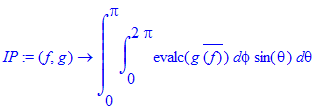
Atomic Lifetimes
A calculation of the lifetimes of excited atomic hydrogen levels associated with the spontaneous decay. The basics are explained in Liboff, some details are provided in Bethe-Salpeter.
First we need normalized hydrogen wavefunctions with separate radial and angular parts.
| > | restart; |
| > | with(plots): |
Warning, the name changecoords has been redefined
We define the radial wavefunctions for hydrogen and the corresponding radial integrals:
| > | F:=(n,l,r)->simplify(add((-1)^i*((n+l)!)^2*r^i/(i!*(n-l-1-i)!*(2*l+1+i)!),i=0..n-l-1)); |

| > | F(1,0,r); |
![]()
| > | F(2,0,r); |
![]()
| > | F(2,1,r); |
![]()
| > | A:=(n,l)->sqrt((n-l-1)!/(2*n*((n+l)!)^3)); |

| > | Z:='Z'; |
![]()
| > | #assume(Z>0); |
| > | R:=proc(n,l,r) local k,rho; global Z; |
| > | k:=Z/n; rho:=2*k*r; |
| > | A(n,l)*rho^l*exp(-rho/2)*F(n,l,rho)*(2*k)^(3/2); end: |
| > | R(1,0,r); |

| > | int(%^2*r^2,r=0..infinity) assuming Z>0; |
![]()
| > | R(2,0,r); |
| > | int(%^2*r^2,r=0..infinity) assuming Z>0; |

![]()
| > | simplify(R(2,1,r)); |

| > | int(%^2*r^2,r=0..infinity) assuming Z>0; |
![]()
| > | plot([subs(Z=1,r*R(4,0,r)),subs(Z=1,r*R(4,1,r)),subs(Z=1,r*R(4,2,r)),subs(Z=1,r*R(4,3,r))],r=0..60); |
![[Maple Plot]](images/AtomicLifetime13.gif)
These radial functions are normalized. Are they orthogonal?
| > | int(expand(R(2,0,r)*R(1,0,r)*r^2),r=0..infinity) assuming Z>0; |

Maple should not have trouble with this! For some reason maple9.03 or 9.5 doesn't figure this one out.
The angular parts of any central-force problem are spherical harmonics.
| > | with(orthopoly); |
![]()
| > | Plm:=proc(theta,l::nonnegint,m::integer) local x,y,f; |
| > | x:=cos(theta); |
| > | if m>0 then f:=subs(y=x,diff(P(l,y),y$m)); |
| > | else f:=subs(y=x,P(l,y)); fi; |
| > | (-1)^m*sin(theta)^m*f; end: |
| > | Plm(theta,3,2); |
![]()
For the spherical harmonics we don't need the Plm's with negative argument.
| > | Y:=proc(theta,phi,l::nonnegint,m::integer) local m1; |
| > | m1:=abs(m); if m1>l then RETURN("|m} has to be <= l for Y_lm"); fi; |
| > | exp(I*m*phi)*Plm(theta,l,m1)*(-1)^m*sqrt((2*l+1)*(l-m1)!/(4*Pi*(l+m1)!)); end: |
| > | Y(theta,phi,3,0); |

| > | Y(theta,phi,3,1); |

| > | No:=(l,m)->int(int(evalc(Y(theta,phi,l,m)*conjugate(Y(theta,phi,l,m))),phi=0..2*Pi)*sin(theta),theta=0..Pi); |

| > | No(1,0); |
![]()
| > | No(1,1); |
![]()
Suppose I need to calculate the electrostatic potential for a wavefunction in a superposition of hydrogenic orbitals.
What is the angular dependence of the product terms?
| > | IP:=(f,g)->int(int(evalc(g*conjugate(f)),phi=0..2*Pi)*sin(theta),theta=0..Pi); |

| > | IP(Y(theta,phi,1,0),Y(theta,phi,3,0)); |
![]()
The required matrix element involves as the operator the position vector [x, y, z] expressed as r*[sin(theta)*cos(phi), sin(theta)*sin(phi), cos(theta)]
The radial part of the matrix element is defined first. We need to set the charge:
| > | Z:=1; |
![]()
| > | RME:=(n,l,np,lp)->int(r^3*R(n,l,r)*R(np,lp,r),r=0..infinity); |

| > | RME(2,1,1,0); |
![]()
Now the part where the polar and azimuthal angles theta and phi are integrated:
| > | AME:=(l,m,lp,mp)->abs(IP(Y(theta,phi,l,m),sin(theta)*cos(phi)*Y(theta,phi,lp,mp)))^2+abs(IP(Y(theta,phi,l,m),sin(theta)*sin(phi)*Y(theta,phi,lp,mp)))^2+abs(IP(Y(theta,phi,l,m),cos(theta)*Y(theta,phi,lp,mp)))^2; |
![]()
| > | AME(1,0,0,0); |
![]()
The phase-space factor omega^3 is defined now, where hbar*omega is the photon energy calculated from the difference of electronic energy levels. We choose atomic units in which hbar=m=e=1 :
| > | ED:=(n,np)->-Z^2/2*(1/n^2-1/np^2); |

| > | c:=137.04: alpha:=1/c: |
| > | Acof:=(n,l,m,np,lp,mp)->evalf(RME(n,l,np,lp)^2*AME(l,m,lp,mp)*ED(n,np)^3*4/3*alpha/c^2,4); |

| > | Acof(2,1,0,1,0,0); |
![]()
This is the A coefficient in atomic units. To obtain the lifetime, we take the inverse, and convert to nanoseconds. The atomic time unit is approximately 2.4E-17 s?
In nanoseconds:
| > | atu:=2.418884E-17; # the atomic time unit to 7 digits (it is known more accurately) |
![]()
| > | evalf(1/Acof(2,1,0,1,0,0)*atu*1E9,3); |
![]()
The special case of maximal angular momentum states which can only decay to the nearest neighbour:
| > | C1:=n->evalf(1/Acof(n,n-1,n-1,n-1,n-2,n-2)*atu*1E9,4); |

| > | C1(2); |
![]()
| > | seq(C1(n),n=2..20); |
![]()
These numbers look right when compared to an analytic evaluation of the integrals. In particular, they can be compared with the closed-form expression (31) in M Seidl and P O Lipas: Eur. J. Phys. 17, 25 (1996) for the lifetimes in nanoseconds:
| > | C1a:=n->evalf(0.0622*3*n^4*(n-1)^2/(2*n-1)*(1+1/4/n/(n-1))^(2*n),4); |

| > | seq(C1a(n),n=2..20); |
![]()
For other initial states (non-maximal angular momentum), the situation is more complicated due to the presence of various decay channels. We begin by providing explicit expressions that sum over the allowed m -sublevels. The selection rules are: +/- 1 in l (L), and 0, +/-1 in m . For the initial state we pick n,l,m . We need to know how Acof responds for non-allowed cases.
| > | Acof(2,1,0,2,2,0); |
Error, (in A) numeric exception: division by zero
Thus, we need to protect the procedure from illegal calls.
| > | AcofSp:=(n,l,m,np)->if l+1 < np then add(Acof(n,l,m,np,l+1,mp),mp=max(m-1,-l-1)..min(m+1,l+1)) else 0 fi; |
![]()
| > | AcofSp(2,1,0,1); |
![]()
| > | AcofSp(4,1,1,3); |
![]()
| > | AcofSp(4,1,1,2); |
![]()
Why would the last one be forbidden? 4p1->2d final state does not exist.
Now look at lowering l (L) by one unit.
| > | AcofSm:=(n,l,m,np)->if l-1 < np and l-1>=0 then add(Acof(n,l,m,np,l-1,mp),mp=max(m-1,-l+1)..min(m+1,l-1)) else 0 fi; |
![]()
| > | AcofSm(4,2,1,2),AcofSm(4,2,1,3); |
![]()
This shows the phase-space factor effect. The Einstein coefficient provides a decay rate: the decay from n=4 is faster to n=2 than it is to n=3 .
Now let us demonstrate that the decay rate for the case when l decreases beats the one for increasing l .
| > | AcofSm(4,1,0,3),AcofSp(4,1,0,3); |
![]()
There is almost an order-of-magnitude difference. The answer is independent of the initial magnetic quantum number (apart from inaccuracies).
| > | AcofSm(4,1,-1,3),AcofSp(4,1,-1,3); |
![]()
Exercise 1:
Calculate the transition rates to all possible final states for |3s>, |3p>, |3d>, and for |4s>, |4p>, |4d>, |4f> and compare them to a table (e.g., Radzig+Smirnov). Then calculate the total transition rates and lifetimes for these states.
| > |